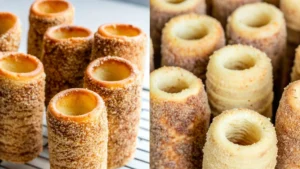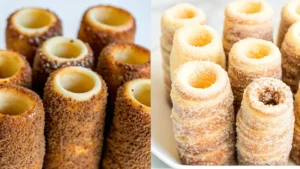What is Chimney Cake?
Chimney Cake is a hollow, spiral-shaped pastry made from sweet yeast dough. Baked over an open flame or in a specialized rotisserie, its exterior is golden and crisp, while the interior remains soft and fluffy. For more ideas on delightful pastries, check out Valentine’s Day Red Velvet Brownie Cookies, which offer a creative and romantic touch to any occasion.
The History and Origins of Chimney Cake
The origins of Chimney Cake can be traced back to Central Europe, particularly Hungary and Transylvania. Historically, it was a festive treat prepared during celebrations and special occasions. To learn more about traditional foods with cultural significance, read Homemade Baby Food Creations, a guide to nourishing meals with nostalgic roots.
How Chimney Cake is Traditionally Made
Traditional Chimney Cake preparation involves rolling sweet yeast dough into thin strips and wrapping it around a wooden or metal spit. The spit is then rotated over an open flame or baked in a rotisserie oven until the dough achieves its signature golden-brown color. As the dough cooks, it’s basted with butter and rolled in sugar, creating a caramelized crust. The process is art and science, requiring careful attention to achieve the perfect texture and flavor.
Step-by-Step Guide to a Perfect Bake
Making Chimney Cake at home can be a rewarding experience. Follow these steps for delicious results:
- Prepare the Dough: Mix flour, yeast, sugar, milk, and eggs to form a soft dough. Knead it thoroughly and let it rise until doubled in size.
- Shape the Strips: Roll out the dough and cut it into even strips.
- Wrap Around Spit: Coil the strips around a greased spit or cylindrical mold.
- Brush with Butter: Ensure the dough is evenly coated for a golden finish.
- Bake or Grill: Cook over an open flame or in a preheated oven, rotating for even browning.
- Add Toppings: Roll the warm cake in sugar, nuts, or your favorite toppings.
This method captures the traditional essence of chimney cake while allowing room for creativity.
Modern Variations of Chimney Cake
While traditional pastry remains a favorite, modern variations cater to evolving tastes. Today, you’ll find Chimney Cakes filled with ice cream, Nutella, or even savory fillings. Vegan and gluten-free versions have also gained popularity, ensuring everyone can enjoy this treat. From matcha-flavored dough to colorful sprinkles, contemporary spins on Chimney Cake showcase its versatility while maintaining its core appeal.
Sweet Toppings for Chimney Cake
The beauty of Chimney Cake lies in its customizable toppings. Popular sweet options include:
- Cinnamon Sugar: A classic choice for added warmth.
- Chocolate Drizzle: Perfect for chocolate lovers.
- Nuts: Crushed almonds, hazelnuts, or walnuts add crunch and richness.
- Coconut Flakes: For a tropical twist.
- Sprinkles: Ideal for festive occasions.
These toppings enhance the flavor and make this pastry visually appealing, adding a layer of indulgence to this already delightful dessert.
Savory Options: A New Twist on Chimney Cake
While Chimney Cake is traditionally sweet, savory versions have emerged as a modern twist. Imagine dough infused with herbs, garlic, or cheese, baked to perfection, and topped with savory fillings. Popular options include:
- Cheese and Herb: A melty, aromatic delight.
- Garlic Butter: For a rich, garlicky flavor.
- Spiced Meats: Sausages or pepperoni for a hearty snack.
- Vegetable Fillings: Roasted peppers, onions, or spinach for a vegetarian option.
These savory takes expand Chimney Cake’s appeal, making it a versatile dish suitable for any time of day.
Regional Variations of Chimney Cake Around the World
Chimney Cake, though deeply rooted in Hungarian tradition, has transcended borders and evolved into a globally loved treat. In Romania, it’s known as Kürtőskalács and retains its classic preparation, often flavored with cinnamon or vanilla. In the Czech Republic, Trdelník is a popular variation, sometimes filled with whipped cream it ice cream. Slovakia and Poland also have their versions, with subtle differences in toppings and baking methods. Asthis pastry gained international fame, adaptations in the U.S. and Asia introduced bold flavors like matcha, salted caramel, and Oreo crumble. These regional variations highlight the pastry’s universal appeal and adaptability to diverse palates.
Chimney Cake as a Festive Dessert: Tradition and Creativity Combined
Chimney Cake is synonymous with celebration. Traditionally prepared during festivals, weddings, and holidays, its warm, sugary aroma fills the air, evoking joy and nostalgia. During Christmas markets across Europe, stalls offering freshly baked this pastry attract crowds with their mesmerizing preparation. Coated with sugar, cinnamon, or festive sprinkles, it embodies the spirit of the season. Additionally, its customizable nature makes it a versatile addition to any festive menu, whether adorned with red and green toppings or served with a dollop of whipped cream.
The Cultural Significance of Chimney Cake in Hungary
In Hungary, Chimney Cake is more than a dessert; it’s a cultural treasure. Known as Kürtőskalács, it represents hospitality, community, and culinary heritage. Historically, it was prepared during special occasions, symbolizing abundance and unity. Traditional recipes were often passed down through generations, preserving the authentic taste and techniques. Festivals dedicated to this pastry celebrate its importance, with bakers showcasing their skills and visitors enjoying freshly made pastries. As a symbol of Hungarian identity, this pastry bridges the gap between the past and present, connecting people through shared traditions.
Why Chimney Cake is Popular in Street Food Markets
The charm of chimney cake lies in its street food appeal. Its preparation is as captivating as its taste, with vendors skillfully wrapping dough around spits, grilling it, and coating it with toppings. This interactive process attracts customers, turning this pastryinto an experience. Its portability and versatility further contribute to its popularity in street food markets. Whether enjoyed as a quick snack or a decadent dessert, Chimney Cake satisfies cravings with its perfect balance of texture and flavor. The addition of creative fillings like ice cream or Nutella has further solidified its position as a street food favorite.
Where to Find the Best Chimney Cake
To experience the finest chimney cake, visiting Hungary is a must. Cities like Budapest boast renowned bakeries and street vendors serving authentic Kürtőskalács. European Christmas markets, especially in Prague, Vienna, and Bratislava, are also excellent places to indulge in traditional and modern variations. For a global twist, cities with vibrant food scenes, such as London, New York, and Tokyo, offer innovative takes on chimney cake. Dedicated This Pastry shops and pop-ups ensure this treat is accessible worldwide, providing both authenticity and creativity.
How to Make Chimney Cake at Home
Recreating this pastry at home is simpler than it seems. Start by preparing a soft yeast dough using flour, sugar, yeast, milk, eggs, and butter. Allow the dough to rise, then roll it into strips. Wrap the strips around a greased mold or cylindrical object, such as a rolling pin or oven-safe tube. Brush the dough with melted butter, sprinkle with sugar, and bake in a preheated oven. Rotate the mold for even browning. Once golden, roll the hot This Pastry in your choice of toppings, such as cinnamon sugar, nuts, or shredded coconut. This homemade version captures the essence of this pastry while allowing for personalized touches.
Frequently Asked Questions
What is Chimney Cake made of?
Bakers craft Chimney Cake using sweet yeast dough, which includes flour, sugar, milk, butter, and eggs. They coat the dough with sugar before baking to achieve a caramelized crust and often add flavorful toppings.
Is This Pastry always sweet?
While traditionally sweet, savory versions with cheese, herbs, or spices have become popular in recent years.
Can This Pastry be gluten-free or vegan?
Yes, there are gluten-free and vegan recipes available, using alternative flours and plant-based ingredients.
How long does This Pastry stay fresh?
Chimney Cake is best enjoyed fresh, but it can be stored for up to two days in an airtight container.
Where can I buy Chimney Cake molds?
Specialized baking stores and online retailers offer this pastry molds for home baking enthusiasts.
What is the origin of the name “This Pastry”?
The name “This Pastry” comes from its hollow, cylindrical shape and the steam that rises from it when freshly baked, resembling smoke coming out of a chimney.
What are the best toppings for Chimney Cake?
Popular sweet toppings include cinnamon sugar, chocolate, crushed nuts, and coconut flakes. Savory options include cheese, garlic butter, and herbs. The choice of toppings depends entirely on personal preference.
How do bakers traditionally cook Chimney Cake?
They wrap the dough around a wooden or metal spit and roast it over an open flame. During cooking, they baste it with butter and sprinkle it with sugar for a caramelized finish.
Can I make Chimney Cake without a spit?
Yes, you can use oven-safe cylindrical molds, such as metal cans or rolling pins, to mimic the traditional spit method. These work well for home baking.
FAQs
Are there gluten-free or vegan options for This Pastry?
Yes, gluten-free versions use alternative flours like rice or almond flour, while vegan recipes substitute eggs and dairy with plant-based ingredients such as almond milk and flaxseed.
How long does it take to bake Chimney Cake?
The baking time depends on the method and heat source but generally takes about 10–15 minutes in an oven or over an open flame.
Can Chimney Cake be frozen for later use?
While it’s best enjoyed fresh,this pastry can be frozen after cooling. To reheat, place it in an oven at a low temperature to restore its texture.
Is Chimney Cake suitable for children?
Absolutely! Its soft interior and customizable toppings make this pastry a favorite among children, who often enjoy adding their own choice of sprinkles or chocolate.
What beverages pair well with This Pastry?
This Pastry pairs wonderfully with coffee, tea, or hot chocolate. For a festive twist, it can also be enjoyed with mulled wine or cider.
The Timeless Charm of this pastry
Chimney Cake’s enduring appeal lies in its perfect blend of tradition and innovation. Its spiral shape, caramelized crust, and customizable flavors make it a treat that resonates with all ages. Whether enjoyed during a festive gathering, at a bustling street market, or in the comfort of your home, this pastry delivers a sense of warmth and indulgence. Its global adaptations ensure it remains relevant and cherished, cementing its status as a timeless culinary delight.
Conclusion
this pastry is more than just a pastry; it’s a celebration of tradition, culture, and creativity. From its Hungarian roots to its global variations, this versatile dessert continues to enchant food lovers everywhere. Whether you savor it as a sweet street food snack or explore its savory potential, this pastryoffers something for everyone. Its timeless charm ensures that it will remain a beloved treat for generations to come.
PrintChimney Cake: Discover Its History, Variations, and Recipes
- Prep Time: 1 hour 30 minutes
- Cook Time: 15 minutes
- Total Time: 1 hour 45 minutes
- Yield: 4–6 Chimney Cakes
- Category: Dessert, Street Food
- Method: Baking or Grilling
- Cuisine: Hungarian, Central European
- Diet: Vegetarian
Description
Chimney Cake, also known as Kürtőskalács, is a traditional Hungarian pastry that delights with its spiral shape, golden caramelized crust, and irresistible aroma. Made from sweet yeast dough, this treat offers a crispy exterior and soft, fluffy interior, making it a favorite worldwide. Originally a festive dessert, Chimney Cake has evolved into a versatile delicacy, enjoyed with customizable toppings like cinnamon sugar, chocolate drizzle, nuts, or even savory fillings. Whether as a street food snack or a festive indulgence, Chimney Cake combines cultural heritage with modern creativity, ensuring a timeless appeal for every palate.
Ingredients
For the Dough:
- 3 cups (375g) all-purpose flour
- 1 packet (7g) instant yeast
- 1/4 cup (50g) granulated sugar
- 1/2 cup (120ml) warm milk
- 2 tablespoons (30g) unsalted butter, melted
- 1 large egg
- 1/4 teaspoon salt
- 1 teaspoon vanilla extract (optional, for added flavor)
For the Coating:
- 1/4 cup (50g) melted butter (for brushing)
- 1/2 cup (100g) granulated sugar
- 1 teaspoon cinnamon (optional, for flavor)
Optional Toppings:
- Crushed nuts (e.g., almonds, walnuts, or hazelnuts)
- Shredded coconut
- Chocolate drizzle
- Sprinkles
- Savory options: grated cheese, garlic butter, or herbs
This ingredient list provides the foundation for a classic Chimney Cake
Instructions
Step 1: Prepare the Dough
In a mixing bowl, combine warm milk, sugar, and instant yeast. Stir and let it sit for 5–10 minutes until frothy.
Add flour, salt, melted butter, egg, and vanilla extract (if using). Mix until a soft dough forms.
Knead the dough on a floured surface for 8–10 minutes until smooth and elastic.
Place the dough in a greased bowl, cover with a clean kitchen towel, and let it rise in a warm place for about 1–2 hours, or until doubled in size.
Step 2: Shape the Chimney Cake
Preheat your oven to 375°F (190°C) or prepare your rotisserie/grill.
Roll the dough into a large rectangle, approximately 1/4-inch thick.
Cut the dough into long strips, about 1-inch wide.
Lightly grease your Chimney Cake molds (or cylindrical substitutes like rolling pins or cans). Wrap each strip of dough around the mold, overlapping slightly.
Step 3: Brush and Coat
Brush the wrapped dough with melted butter, ensuring it is evenly coated.
Roll the coated dough in a mixture of sugar and cinnamon (or your desired topping).
Step 4: Bake or Grill
Place the prepared molds on a baking tray or rotisserie.
Bake in the preheated oven for 10–15 minutes, rotating occasionally, until the dough is golden brown and caramelized. If using a grill, rotate the mold over the flame for even cooking.
Step 5: Add Toppings
Remove the Chimney Cakes from the molds while still warm.
Sprinkle with additional toppings like crushed nuts, coconut, or chocolate drizzle as desired.
Step 6: Serve and Enjoy
Serve the Chimney Cake warm for the best taste and texture.
Pair with your favorite beverages like coffee, tea, or hot chocolate, and enjoy this delightful treat!
Notes
- Dough Consistency:
Ensure the dough is soft but not sticky. If it feels too wet, add a small amount of flour, 1 tablespoon at a time, until manageable. - Yeast Activation:
Use warm (not hot) milk to activate the yeast. The temperature should be around 110°F (43°C) to avoid killing the yeast. - Substitute for Molds:
If you don’t have Chimney Cake molds, use oven-safe cylindrical items like rolling pins, metal cans, or even a thick bottle covered with aluminum foil. - Even Baking:
Rotate the molds frequently during baking or grilling to ensure even browning and caramelization. - Topping Variations:
Experiment with different toppings like crushed nuts, coconut, sprinkles, or even savory options like cheese and herbs. Adjust the sugar in the dough for savory versions. - Vegan Option:
Replace butter with a plant-based alternative, milk with almond or oat milk, and the egg with a flaxseed or chia seed substitute.
Nutrition
- Serving Size: 1 Chimney Cake (based on a batch of 4–6 cakes)
- Calories: 320 kcal
- Sugar: 15 g
- Sodium: 150 mg
- Fat: 8 g
- Saturated Fat: 4 g
- Unsaturated Fat: 4 g
- Trans Fat: 0 g
- Carbohydrates: 50 g
- Fiber: 2 g
- Protein: 7 g
- Cholesterol: 40 mg



